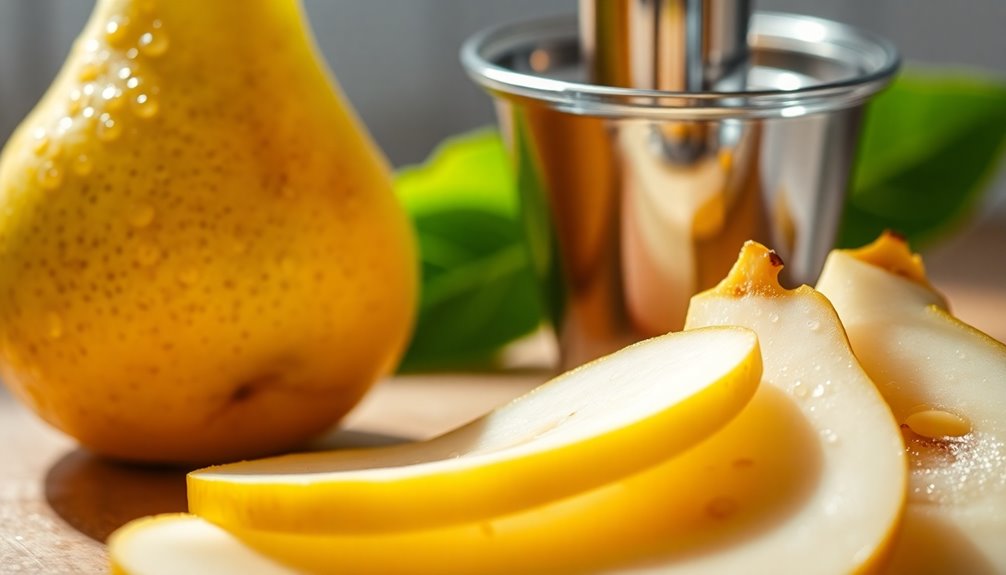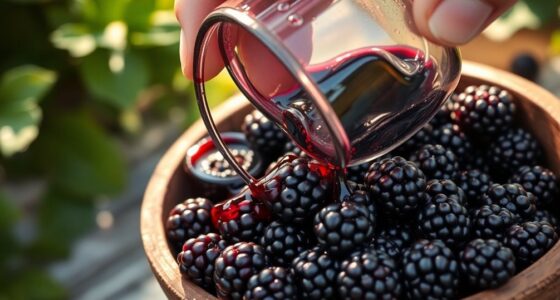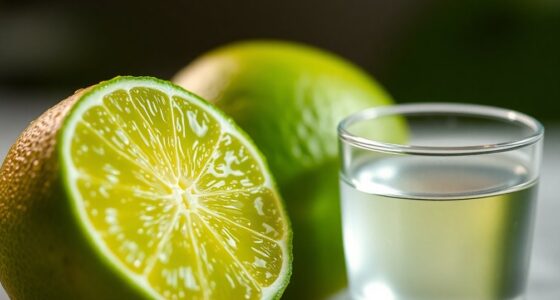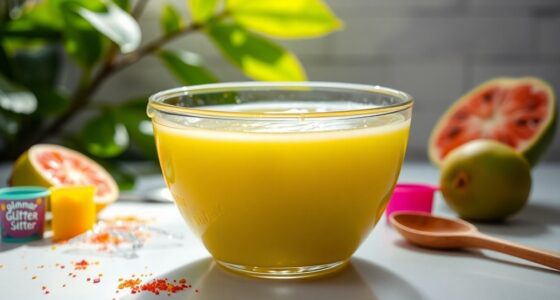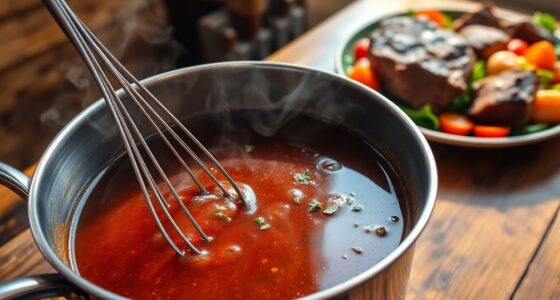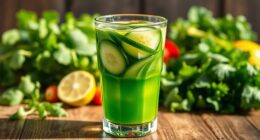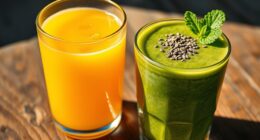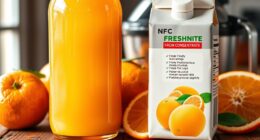To juice pears, start with ripe Asian pears. Wash, peel, and core them, then cut into smaller pieces. Blend the chopped pears with two cups of chilled water until smooth. If you like, add lemon juice or ginger for extra flavor. Strain the mixture through a sieve. If you have a juicer, simply quarter the pears and feed them in. Enjoy your refreshing juice right away for the best flavor and nutrition. Discover more tips for delicious variations! You can also experiment with combining pear juice with other fruits for a unique blend. For example, adding apples or berries can enhance the sweetness and complexity of your drink. If you’re looking for a tropical twist, you might also want to learn how to prepare papaya juice, which pairs wonderfully with pear for a refreshing and nutritious beverage. Enjoy exploring different flavor combinations to find your perfect juice!
Key Takeaways
- Select ripe Asian pears, wash them thoroughly, peel, core, and cut them into smaller pieces for easier juicing.
- Use a blender with two cups of chilled water and optional flavor additives like lemon juice for a smooth pear juice.
- Strain the blended mixture through a fine mesh sieve or cheesecloth to separate the juice from the pulp.
- For juicer users, simply quarter the pears and feed them through the juicer for quick extraction.
- Consume pear juice immediately for the best flavor and nutritional benefits, or store in the refrigerator for up to four days.

Juicing pears is a delicious way to enjoy their sweet, refreshing flavor and health benefits. When you think about homemade fruit juices, pears often get overlooked, but they offer a unique taste and a wealth of nutrients. If you're ready to try juicing pears, you'll find that it's simple and rewarding. Start by selecting ripe Asian pears, known for their juiciness and sweetness. Ripe pears will give you the best results in your pear juice recipe.
Once you've got your pears, wash them thoroughly to remove any dirt or pesticides. Next, peel and core each pear to get rid of any tough bits. After that, cut them into smaller pieces. This step is crucial because it makes blending or juicing much easier.
If you're using a blender, toss the chopped pears into the blender jar and add two cups of chilled water. For a little extra zing, consider adding some lemon juice or ginger. Blend until smooth, then strain the mixture through a fine mesh sieve or cheesecloth to get a clear, delicious pear juice.
If you prefer using a juicer, the process is even more straightforward. Simply quarter the pears and feed them through the juicer. You could even combine pears with other fruits like oranges for added flavor. This combination can elevate the taste of your homemade pear juice considerably. Whichever method you choose, you're in for a treat with this fresh pear juice.
One of the best things about juicing pears is their impressive nutritional profile. Pears are a great source of Vitamin C, which is essential for your immune system. When you drink your homemade pear juice, you not only enjoy a delightful flavor but also reap the health benefits.
However, keep in mind that pear juice is best consumed immediately after preparation. This is because oxidation can diminish both the flavor and the health properties of your juice.
If you happen to have any leftover juice, store it in the refrigerator. Make sure to use sterilized containers to maximize shelf life, and aim to consume it within four days. You might be tempted to add sugar to enhance the sweetness, but if you pick ripe pears, you'll find that they're naturally sweet enough.
Juicing pears gives you an easy way to enjoy a refreshing drink that's packed with flavor and nutrients. Whether you're sipping on fresh pear juice alone or mixing it with other fruit juices, you'll appreciate the delicious, wholesome experience.
Frequently Asked Questions
Do You Peel Pears Before Juicing?
Yes, you should peel pears before juicing, especially if they're not organic. Peeling removes pesticides and wax, ensuring a cleaner juice.
It also gives you a smoother texture since the skin can make it gritty. If you have organic pears, you can leave the skin on for extra nutrients, but make sure to wash them well.
Regardless, always remove the core and seeds, as they can be harmful in large amounts.
Are Pears Good for Juicing?
Yes, pears are excellent for juicing! Their high water content makes them juicy and refreshing.
When you juice pears, you'll enjoy their natural sweetness without needing added sugars, which keeps it healthier. Plus, they offer health benefits, including antioxidants and vitamins.
Juicing pears can also help with digestive issues thanks to their fiber and natural enzymes.
How Long to Steam Pears for Juice?
To steam pears for juice, you'll want to cook them for about 10-15 minutes.
Cut the pears into smaller pieces to ensure they steam evenly and soften quickly.
Using a steamer basket or a pot with a lid and a bit of water works great.
You'll know they're ready when they're soft and easily mashable.
This method helps retain their natural flavors while making the juicing process smoother.
How Much Juice Does One Pear Make?
Plump pears typically produce a pleasing amount of juice. On average, one medium-sized pear yields about 1/2 to 3/4 cup of juice, but this can vary based on the variety and ripeness.
If you're juicing Asian pears, you might find even more juice. Remember, the method you choose—juicing versus blending—can affect the total yield.
Conclusion
Juicing pears is like unlocking the nectar of the gods! With every squeeze, you're not just extracting juice; you're capturing the essence of fall in a glass. So, grab those luscious pears, and unleash a flood of sweet, golden elixir that could make even the most divine beings weak at the knees. Cheers to your newfound pear juicing prowess—your taste buds will forever sing your praises, and your kitchen will become a sanctuary of fruity delights!
Cindy thoroughly researches juicing trends, techniques, and recipes to provide readers with practical advice and inspiration. Her writing style is accessible, engaging, and designed to make complex concepts easy to understand. Cindy’s dedication to promoting the advantages of juicing shines through her work, empowering readers to make positive changes in their lives through the simple act of juicing.

